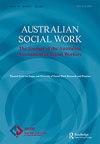Collaboration Between Child Protection and Domestic and Family Violence: A Case File Review
IF 2
3区 社会学
Q2 SOCIAL WORK
引用次数: 2
Abstract
ABSTRACT Collaboration across child protection and domestic and family violence sectors has been identified as central to responding to complexities experienced by families within these practice fields. However, there is little research that explores how collaboration happens and what outcomes are produced. This paper reports on a study that reviewed 21 case files between 2015 and 2019 to identify the indicators of collaboration when domestic and family violence are present along with child protection concerns, and what activities and processes enable collaborative practice at these intersections. The study found that collaboration is visible in case files through activities such as information sharing, referral, planning, and case conferencing. However, analysis of case notes and discussions with practitioners revealed that these indicators do not necessarily lead to collaboration consistently. The implication for practice is that effective collaboration is fundamentally relational. It is through relationship building between agencies, practitioners, and families that collaboration is enacted. IMPLICATIONS Collaboration between child protection and domestic and family violence practitioners can be identified through indictors such as information sharing, referral, shared case planning, and shared case conferencing. The democratising of practice can be seen most clearly at case conferences where information is shared for decision making to support victims of domestic and family violence. Collaboration becomes compromised when information is shared without purposeful and meaningful linkages between agencies, or without the goals of responsive service pathways for women and children and a common risk assessment of the perpetrator.儿童保护与家庭暴力之间的合作:案例回顾
摘要儿童保护、家庭暴力和家庭暴力部门之间的合作已被确定为应对这些实践领域中家庭所经历的复杂性的核心。然而,很少有研究探讨合作是如何发生的以及产生了什么结果。本文报告了一项研究,该研究审查了2015年至2019年间的21份案件档案,以确定在存在家庭暴力和儿童保护问题时的合作指标,以及哪些活动和流程能够在这些交叉点进行合作实践。研究发现,通过信息共享、转介、规划和案例会议等活动,在案例文件中可以看到合作。然而,对案例说明的分析和与从业人员的讨论表明,这些指标并不一定能带来一致的合作。对实践的启示是,有效的合作从根本上讲是关系性的。正是通过机构、从业者和家庭之间的关系建设,才得以开展合作。可以通过信息共享、转介、共享案件规划和共享案件会议等起诉书来确定儿童保护与家庭暴力从业者之间的合作。在案例会议上,可以最清楚地看到实践的民主化,在这些会议上,信息被共享,以供决策支持家庭暴力受害者。当信息共享时,各机构之间没有目的和有意义的联系,或者没有为妇女和儿童提供响应性服务途径的目标,也没有对犯罪者进行共同的风险评估,合作就会受到损害。
本文章由计算机程序翻译,如有差异,请以英文原文为准。
求助全文
约1分钟内获得全文
求助全文
来源期刊

Australian Social Work
SOCIAL WORK-
CiteScore
4.20
自引率
16.70%
发文量
37
期刊介绍:
Australian Social Work is an international peer-reviewed journal reflecting current thinking and trends in Social Work. The Journal promotes the development of practice, policy and education, and publishes original research, theoretical papers and critical reviews that build on existing knowledge. The Journal also publishes reviews of relevant professional literature, commentary and analysis of social policies and encourages debate in the form of reader commentary on articles. Australian Social Work has grown out of the Australian context and continues to provide a vehicle for Australian and international authors. The Journal invites submission of papers from authors worldwide and all contributors are encouraged to present their work for an international readership.
 求助内容:
求助内容: 应助结果提醒方式:
应助结果提醒方式:


